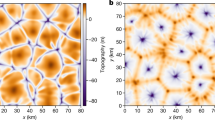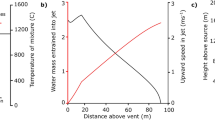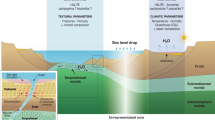Abstract
The discovery of a plume of water vapour and ice particles emerging from warm fractures (‘tiger stripes’) in Saturn's small, icy moon Enceladus1,2,3,4,5,6 raised the question of whether the plume emerges from a subsurface liquid source6,7,8 or from the decomposition of ice9,10,11,12. Previous compositional analyses of particles injected by the plume into Saturn's diffuse E ring have already indicated the presence of liquid water8, but the mechanisms driving the plume emission are still debated13. Here we report an analysis of the composition of freshly ejected particles close to the sources. Salt-rich ice particles are found to dominate the total mass flux of ejected solids (more than 99 per cent) but they are depleted in the population escaping into Saturn's E ring. Ice grains containing organic compounds are found to be more abundant in dense parts of the plume. Whereas previous Cassini observations were compatible with a variety of plume formation mechanisms, these data eliminate or severely constrain non-liquid models and strongly imply that a salt-water reservoir with a large evaporating surface7,8 provides nearly all of the matter in the plume.
This is a preview of subscription content, access via your institution
Access options
Subscribe to this journal
Receive 51 print issues and online access
$199.00 per year
only $3.90 per issue
Buy this article
- Purchase on Springer Link
- Instant access to full article PDF
Prices may be subject to local taxes which are calculated during checkout



Similar content being viewed by others
References
Spahn, F. et al. Cassini dust measurements at Enceladus and implications for the origin of the E ring. Science 311, 1416–1418 (2006)
Dougherty, M. K. et al. Identification of a dynamic atmosphere at Enceladus with the Cassini magnetometer. Science 311, 1406–1409 (2006)
Hansen, C. J. et al. Enceladus' water vapor plume. Science 311, 1422–1425 (2006)
Waite, J. H. et al. Cassini Ion and Neutral Mass Spectrometer: Enceladus plume composition and structure. Science 311, 1419–1422 (2006)
Spencer, J. R. et al. Cassini encounters Enceladus: background and the discovery of a south polar hot spot. Science 311, 1401–1405 (2006)
Porco, C. C. et al. Cassini observes the active south pole of Enceladus. Science 311, 1393–1401 (2006)
Schmidt, J., Brillantov, N., Spahn, F. & Kempf, S. Slow dust in Enceladus' plume from condensation and wall collisions in tiger stripe fractures. Nature 451, 685–688 (2008)
Postberg, F. et al. Sodium salts in E ring ice grains from an ocean below the surface of Enceladus. Nature 459, 1098–1101 (2009)
Kieffer, S. W. et al. A clathrate reservoir hypothesis for Enceladus' south polar plume. Science 314, 1764–1766 (2006)
Gioia, G., Chakraborty, P., Marshak, S. & Kieffer, W. Unified model of tectonics and heat transport in a frigid Enceladus. Proc. Natl Acad. Sci. USA 104, 13578–13581 (2007)
Nimmo, F., Spencer, J. R., Pappalardo, R. T. & Mullen, M. E. Shear heating as the origin of the plumes and heat flux on Enceladus. Nature 447, 289–291 (2007)
Kieffer, S. et al. A redetermination of the ice/vapor ratio of Enceladus’ plumes: implications for sublimation and the lack of a liquid water reservoir. Icarus 203, 238–241 (2009)
Schneider, N. M. et al. No sodium in the vapour plumes of Enceladus. Nature 459, 1102–1104 (2009)
Srama, R. et al. The Cassini cosmic dust analyzer. Space Sci. Rev. 114, 465–518 (2004)
Hillier, J. K. et al. The composition of Saturn's E ring. Mon. Not. R. Astron. Soc. 388, 1588–1596 (2007)
Postberg, F. et al. The E-ring in the vicinity of Enceladus II. Probing the moon’s interior — the composition of E-ring particles. Icarus 193, 438–454 (2008)
Zolotov, M. Y. An oceanic composition on early and today's Enceladus. Geophys. Res. Lett. 34, L23203 (2007)
Kempf, S. et al. Enceladus dust production — new insights from Cassini. Am. Geophys. Union Fall Meet. abstr. P33A–1562. (2010)
Hedman, M. et al. Spectral observations of the Enceladus plume with Cassini-VIMS. Astrophys. J. 693, 1749–1762 (2009)
Sremcevic, M. et al. Impact-generated dust clouds around planetary satellites: asymmetry effects. Planet. Space Sci. 51 (issue 7–8). 455–471 (2003)
Hansen, C. J. et al. The composition and structure of the Enceladus plume. Geophys. Res. Lett. 38, L11202 (2011)
Spitale, J. N. & Porco, C. C. Association of jets on Enceladus with the warmest regions on its south-polar fractures. Nature 449, 695–697 (2007)
Halevy, I. & Stewart, S. T. Is Enceladus' plume tidally controlled? Geophys. Res. Lett. 35 L12203 10.1029/2008GL034349 (2008)
Waite, J. H. et al. Liquid water on Enceladus from observations of ammonia and 40Ar in the plume. Nature 460, 487–490 (2009)
Waite, J. H., Jr, Magee, B. & Brockwell, T. The effect of flyby velocity on the composition of the Enceladus gas torus as measured by Cassini INMS. Proc. Lunar Planet. Sci. Conf. 42, 2818 (2011)
Tian, F., Stewart, A. I. F., Toon, O. B., Larsen, K. W. & Esposito, L. W. Monte Carlo simulations of water vapour plumes on Enceladus. Icarus 188, 154–161 (2007)
Acknowledgements
We thank G. Moragas-Klostermeyer and S. Helfert for their efforts in preparing the CDA plume observations. We acknowledge the work of the scientists and engineers of the Cassini Team at JPL. This work was supported by Deutsches Zentrum für Luft und Raumfahrt (DLR) and Deutsche Forschungs Gemeinschaft (DFG programme ‘The first 10 million years of the solar system’). J.H. was supported by the UK Science and Technology Facilities Council.
Author information
Authors and Affiliations
Contributions
F.P. led the analysis and write-up of the manuscript. J.S. led the dynamical modelling and contributed to data analysis and text. J.H. and S.K. contributed to data analysis and text. S.K. and R.S. designed the CDA plume measurement.
Corresponding author
Ethics declarations
Competing interests
The authors declare no competing financial interests.
Supplementary information
Supplementary Information
The file contains Supplementary Figures 1-10 with legends, Supplementary Text and additional references. (PDF 805 kb)
Rights and permissions
About this article
Cite this article
Postberg, F., Schmidt, J., Hillier, J. et al. A salt-water reservoir as the source of a compositionally stratified plume on Enceladus. Nature 474, 620–622 (2011). https://doi.org/10.1038/nature10175
Received:
Accepted:
Published:
Issue Date:
DOI: https://doi.org/10.1038/nature10175
This article is cited by
-
MASPEX-Europa: The Europa Clipper Neutral Gas Mass Spectrometer Investigation
Space Science Reviews (2024)
-
Detection of phosphates originating from Enceladus’s ocean
Nature (2023)
-
Low effective ultraviolet exposure ages for organics at the surface of Enceladus
Communications Earth & Environment (2023)
-
Sustained and comparative habitability beyond Earth
Nature Astronomy (2023)
-
Particle entrainment and rotating convection in Enceladus’ ocean
Communications Earth & Environment (2023)
Comments
By submitting a comment you agree to abide by our Terms and Community Guidelines. If you find something abusive or that does not comply with our terms or guidelines please flag it as inappropriate.



